dashboard FIAT DOBLO 2009 2.G Owners Manual
[x] Cancel search | Manufacturer: FIAT, Model Year: 2009, Model line: DOBLO, Model: FIAT DOBLO 2009 2.GPages: 274, PDF Size: 6.6 MB
Page 4 of 274

3
KNOW
YOUR
VEHICLE
SAFETY
STARTING
AND
DRIVING
WARNING
LIGHTS AND
MESSAGES
IN AN
EMERGENCY
SERVICING
AND
MAINTENANCE
TECHNICAL
SPECIFICATIONS
INDEXKNOW YOUR VEHICLE
DASHBOARD
The presence and position of the controls, the instruments and the indicators may vary according to the versions.
1. Diffuser for sending air to the side windows – 2. Adjustable and directable air diffuser – 3. Exterior lights control lever
– 4. Instrument panel and warning lights – 5. Windscreen wiper/rear windscreen wiper/trip computer control lever – 6. Ad-
justable and directable air diffusers – 7. Sound system (for versions/markets where provided) – 8. Control Panel – 9. Passenger
air bag (for versions/markets where provided) – 10. Glove compartment – 11. Heating/ventilation/climate control system con-
trols – 12. Gear stick – 13. Starting device – 14. Driver’s air bag – 15. Bonnet release lever.
F0V0185m
Fig. 1
Page 46 of 274
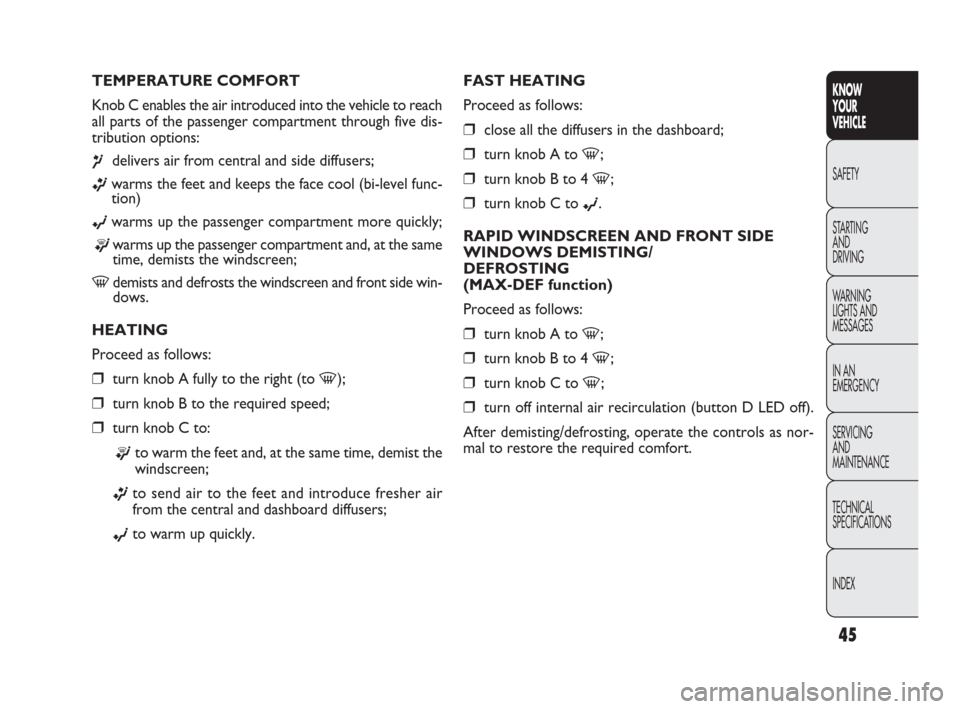
45
KNOW
YOUR
VEHICLE
SAFETY
STARTING
AND
DRIVING
WARNING
LIGHTS AND
MESSAGES
IN AN
EMERGENCY
SERVICING
AND
MAINTENANCE
TECHNICAL
SPECIFICATIONS
INDEX
FAST HEATING
Proceed as follows:
❒close all the diffusers in the dashboard;
❒turn knob A to -;
❒turn knob B to 4 -;
❒turn knob C to ©.
RAPID WINDSCREEN AND FRONT SIDE
WINDOWS DEMISTING/
DEFROSTING
(MAX-DEF function)
Proceed as follows:
❒turn knob A to -;
❒turn knob B to 4 -;
❒turn knob C to -;
❒turn off internal air recirculation (button D LED off).
After demisting/defrosting, operate the controls as nor-
mal to restore the required comfort. TEMPERATURE COMFORT
Knob C enables the air introduced into the vehicle to reach
all parts of the passenger compartment through five dis-
tribution options:
¶delivers air from central and side diffusers;
ßwarms the feet and keeps the face cool (bi-level func-
tion)
©warms up the passenger compartment more quickly;
®warms up the passenger compartment and, at the same
time, demists the windscreen;
-demists and defrosts the windscreen and front side win-
dows.
HEATING
Proceed as follows:
❒turn knob A fully to the right (to -);
❒turn knob B to the required speed;
❒turn knob C to:
®to warm the feet and, at the same time, demist the
windscreen;
ßto send air to the feet and introduce fresher air
from the central and dashboard diffusers;
©to warm up quickly.
Page 55 of 274
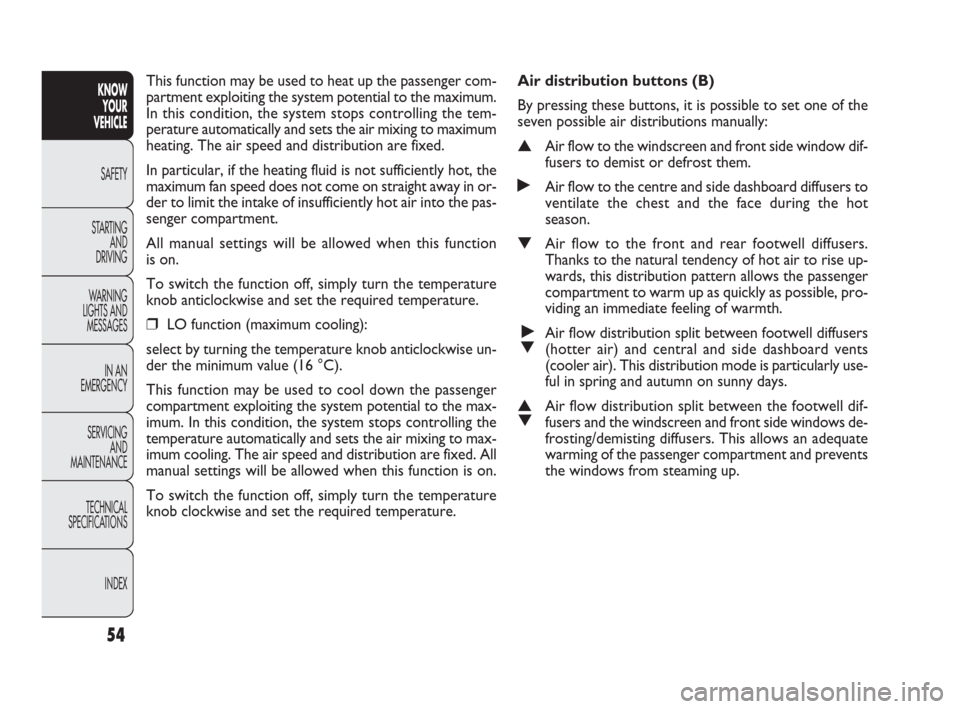
54
KNOW
YOUR
VEHICLE
SAFETY
STARTING
AND
DRIVING
WARNING
LIGHTS AND
MESSAGES
IN AN
EMERGENCY
SERVICING
AND
MAINTENANCE
TECHNICAL
SPECIFICATIONS
INDEX
Air distribution buttons (B)
By pressing these buttons, it is possible to set one of the
seven possible air distributions manually:
▲Air flow to the windscreen and front side window dif-
fusers to demist or defrost them.
˙Air flow to the centre and side dashboard diffusers to
ventilate the chest and the face during the hot
season.
▼Air flow to the front and rear footwell diffusers.
Thanks to the natural tendency of hot air to rise up-
wards, this distribution pattern allows the passenger
compartment to warm up as quickly as possible, pro-
viding an immediate feeling of warmth.
˙
▼Air flow distribution split between footwell diffusers
(hotter air) and central and side dashboard vents
(cooler air). This distribution mode is particularly use-
ful in spring and autumn on sunny days.
▲
▼Air flow distribution split between the footwell dif-
fusers and the windscreen and front side windows de-
frosting/demisting diffusers. This allows an adequate
warming of the passenger compartment and prevents
the windows from steaming up. This function may be used to heat up the passenger com-
partment exploiting the system potential to the maximum.
In this condition, the system stops controlling the tem-
perature automatically and sets the air mixing to maximum
heating. The air speed and distribution are fixed.
In particular, if the heating fluid is not sufficiently hot, the
maximum fan speed does not come on straight away in or-
der to limit the intake of insufficiently hot air into the pas-
senger compartment.
All manual settings will be allowed when this function
is on.
To switch the function off, simply turn the temperature
knob anticlockwise and set the required temperature.
❒LO function (maximum cooling):
select by turning the temperature knob anticlockwise un-
der the minimum value (16 °C).
This function may be used to cool down the passenger
compartment exploiting the system potential to the max-
imum. In this condition, the system stops controlling the
temperature automatically and sets the air mixing to max-
imum cooling. The air speed and distribution are fixed. All
manual settings will be allowed when this function is on.
To switch the function off, simply turn the temperature
knob clockwise and set the required temperature.
Page 56 of 274
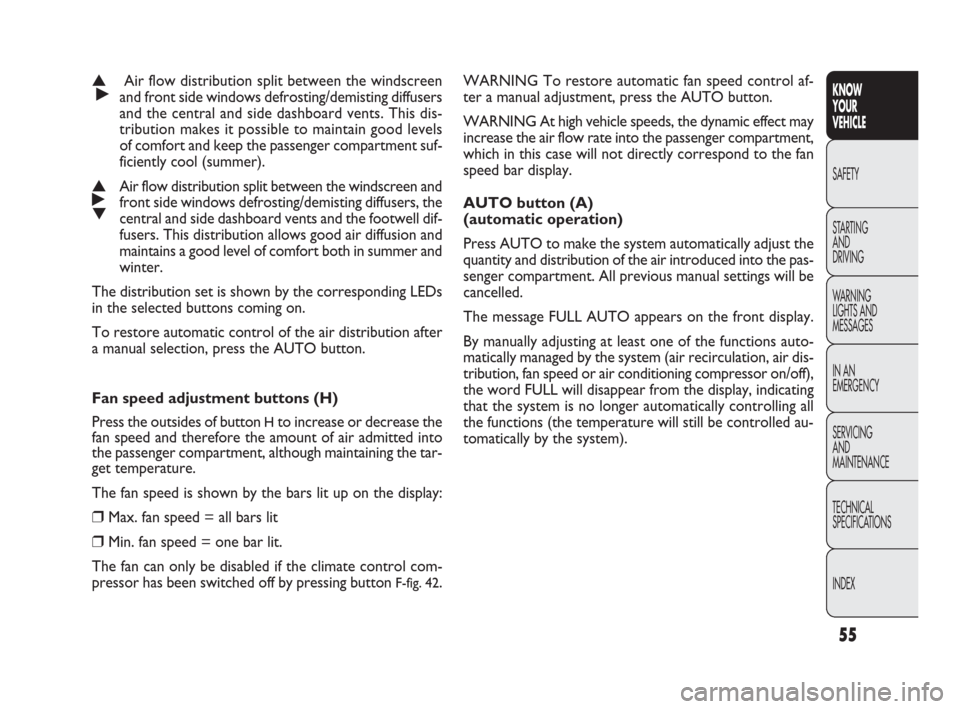
55
KNOW
YOUR
VEHICLE
SAFETY
STARTING
AND
DRIVING
WARNING
LIGHTS AND
MESSAGES
IN AN
EMERGENCY
SERVICING
AND
MAINTENANCE
TECHNICAL
SPECIFICATIONS
INDEX
WARNING To restore automatic fan speed control af-
ter a manual adjustment, press the AUTO button.
WARNING At high vehicle speeds, the dynamic effect may
increase the air flow rate into the passenger compartment,
which in this case will not directly correspond to the fan
speed bar display.
AUTO button (A)
(automatic operation)
Press AUTO to make the system automatically adjust the
quantity and distribution of the air introduced into the pas-
senger compartment. All previous manual settings will be
cancelled.
The message FULL AUTO appears on the front display.
By manually adjusting at least one of the functions auto-
matically managed by the system (air recirculation, air dis-
tribution, fan speed or air conditioning compressor on/off),
the word FULL will disappear from the display, indicating
that the system is no longer automatically controlling all
the functions (the temperature will still be controlled au-
tomatically by the system).▲
˙Air flow distribution split between the windscreen
and front side windows defrosting/demisting diffusers
and the central and side dashboard vents. This dis-
tribution makes it possible to maintain good levels
of comfort and keep the passenger compartment suf-
ficiently cool (summer).
▲
˙
▼Air flow distribution split between the windscreen and
front side windows defrosting/demisting diffusers, the
central and side dashboard vents and the footwell dif-
fusers. This distribution allows good air diffusion and
maintains a good level of comfort both in summer and
winter.
The distribution set is shown by the corresponding LEDs
in the selected buttons coming on.
To restore automatic control of the air distribution after
a manual selection, press the AUTO button.
Fan speed adjustment buttons (H)
Press the outsides of button
Hto increase or decrease the
fan speed and therefore the amount of air admitted into
the passenger compartment, although maintaining the tar-
get temperature.
The fan speed is shown by the bars lit up on the display:
❒Max. fan speed = all bars lit
❒Min. fan speed = one bar lit.
The fan can only be disabled if the climate control com-
pressor has been switched off by pressing button
F-fig. 42.
Page 60 of 274
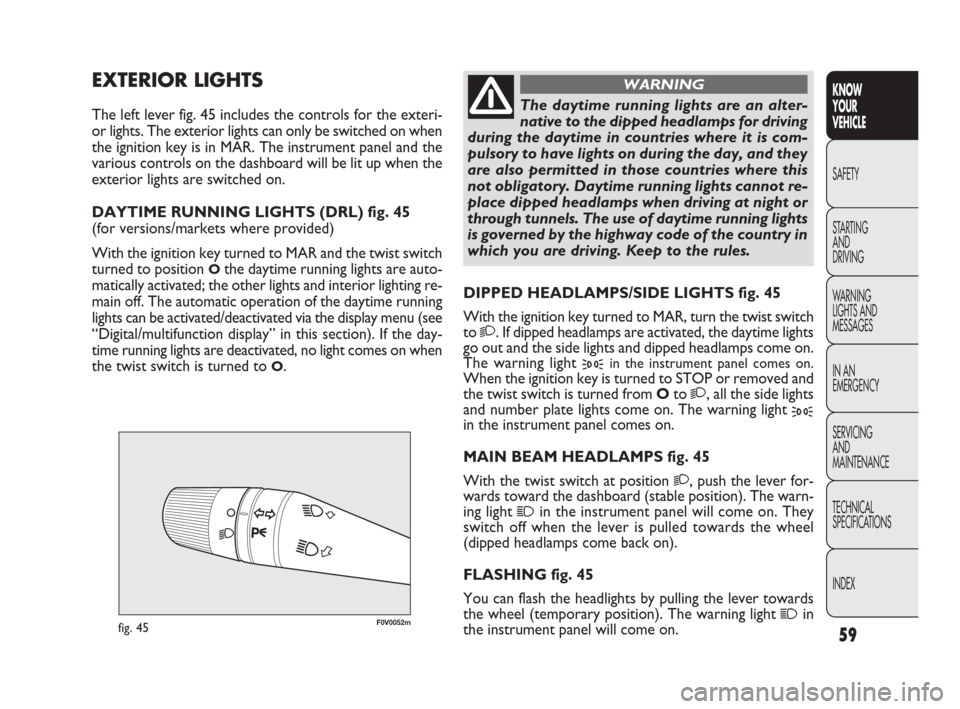
59
KNOW
YOUR
VEHICLE
SAFETY
STARTING
AND
DRIVING
WARNING
LIGHTS AND
MESSAGES
IN AN
EMERGENCY
SERVICING
AND
MAINTENANCE
TECHNICAL
SPECIFICATIONS
INDEX
F0V0052mfig. 45
DIPPED HEADLAMPS/SIDE LIGHTS fig. 45
With the ignition key turned to MAR, turn the twist switch
to
2. If dipped headlamps are activated, the daytime lights
go out and the side lights and dipped headlamps come on.
The warning light
3in the instrument panel comes on.
When the ignition key is turned to STOP or removed and
the twist switch is turned from Oto
2, all the side lights
and number plate lights come on. The warning light
3in the instrument panel comes on.
MAIN BEAM HEADLAMPS fig. 45
With the twist switch at position
2, push the lever for-
wards toward the dashboard (stable position). The warn-
ing light
1in the instrument panel will come on. They
switch off when the lever is pulled towards the wheel
(dipped headlamps come back on).
FLASHING fig. 45
You can flash the headlights by pulling the lever towards
the wheel (temporary position). The warning light
1in
the instrument panel will come on.
EXTERIOR LIGHTS
The left lever fig. 45 includes the controls for the exteri-
or lights. The exterior lights can only be switched on when
the ignition key is in MAR. The instrument panel and the
various controls on the dashboard will be lit up when the
exterior lights are switched on.
DAYTIME RUNNING LIGHTS (DRL) fig. 45
(for versions/markets where provided)
With the ignition key turned to MAR and the twist switch
turned to position
Othe daytime running lights are auto-
matically activated; the other lights and interior lighting re-
main off. The automatic operation of the daytime running
lights can be activated/deactivated via the display menu (see
“Digital/multifunction display” in this section). If the day-
time running lights are deactivated, no light comes on when
the twist switch is turned to
O.
The daytime running lights are an alter-
native to the dipped headlamps for driving
during the daytime in countries where it is com-
pulsory to have lights on during the day, and they
are also permitted in those countries where this
not obligatory. Daytime running lights cannot re-
place dipped headlamps when driving at night or
through tunnels. The use of daytime running lights
is governed by the highway code of the country in
which you are driving. Keep to the rules.
WARNING
Page 63 of 274
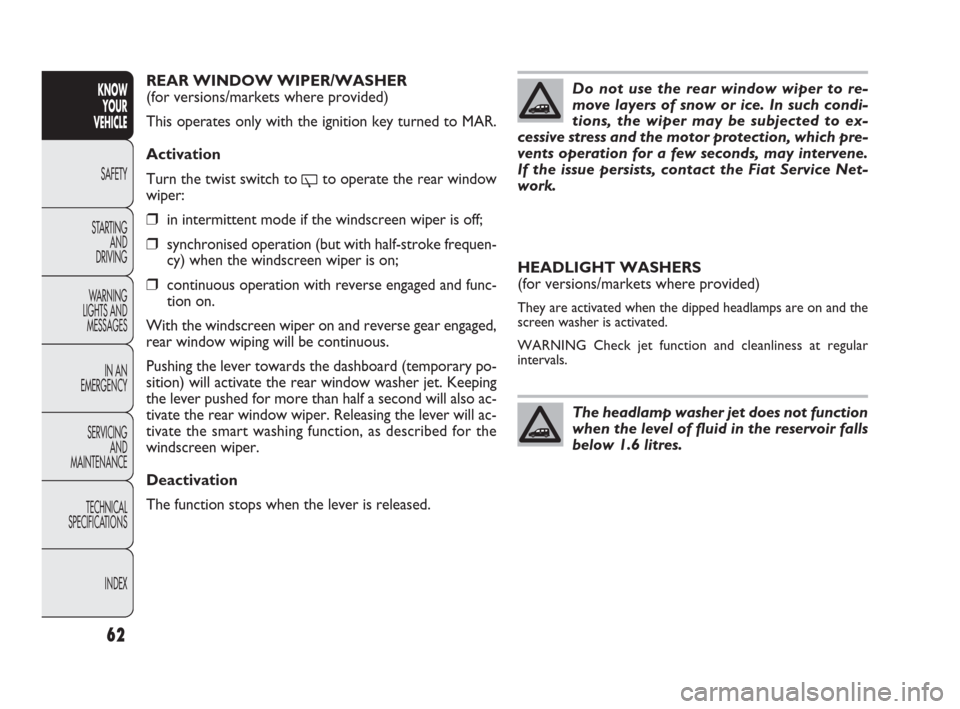
62
KNOW
YOUR
VEHICLE
SAFETY
STARTING
AND
DRIVING
WARNING
LIGHTS AND
MESSAGES
IN AN
EMERGENCY
SERVICING
AND
MAINTENANCE
TECHNICAL
SPECIFICATIONS
INDEX
REAR WINDOW WIPER/WASHER
(for versions/markets where provided)
This operates only with the ignition key turned to MAR.
Activation
Turn the twist switch to
'to operate the rear window
wiper:
❒in intermittent mode if the windscreen wiper is off;
❒synchronised operation (but with half-stroke frequen-
cy) when the windscreen wiper is on;
❒continuous operation with reverse engaged and func-
tion on.
With the windscreen wiper on and reverse gear engaged,
rear window wiping will be continuous.
Pushing the lever towards the dashboard (temporary po-
sition) will activate the rear window washer jet. Keeping
the lever pushed for more than half a second will also ac-
tivate the rear window wiper. Releasing the lever will ac-
tivate the smart washing function, as described for the
windscreen wiper.
Deactivation
The function stops when the lever is released.
Do not use the rear window wiper to re-
move layers of snow or ice. In such condi-
tions, the wiper may be subjected to ex-
cessive stress and the motor protection, which pre-
vents operation for a few seconds, may intervene.
If the issue persists, contact the Fiat Service Net-
work.
HEADLIGHT WASHERS
(for versions/markets where provided)
They are activated when the dipped headlamps are on and the
screen washer is activated.
WARNING Check jet function and cleanliness at regular
intervals.
The headlamp washer jet does not function
when the level of fluid in the reservoir falls
below 1.6 litres.
Page 76 of 274
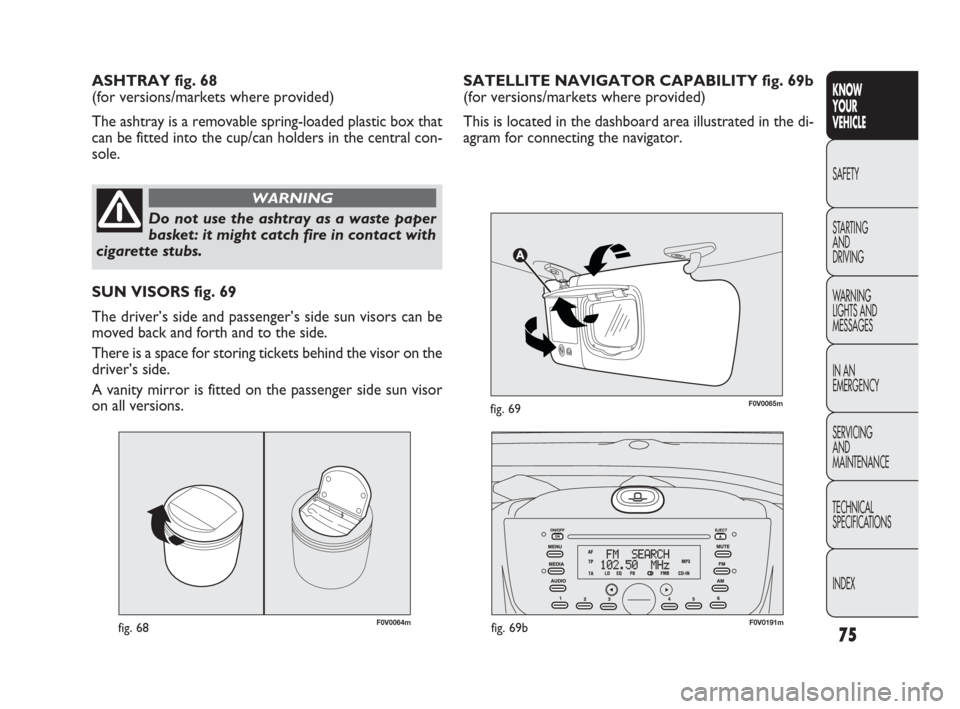
75
KNOW
YOUR
VEHICLE
SAFETY
STARTING
AND
DRIVING
WARNING
LIGHTS AND
MESSAGES
IN AN
EMERGENCY
SERVICING
AND
MAINTENANCE
TECHNICAL
SPECIFICATIONS
INDEX
F0V0064mfig. 68F0V0191mfig. 69b
SUN VISORS fig. 69
The driver’s side and passenger’s side sun visors can be
moved back and forth and to the side.
There is a space for storing tickets behind the visor on the
driver’s side.
A vanity mirror is fitted on the passenger side sun visor
on all versions. ASHTRAY fig. 68
(for versions/markets where provided)
The ashtray is a removable spring-loaded plastic box that
can be fitted into the cup/can holders in the central con-
sole.
Do not use the ashtray as a waste paper
basket: it might catch fire in contact with
cigarette stubs.
WARNING
SATELLITE NAVIGATOR CAPABILITY fig. 69b
(for versions/markets where provided)
This is located in the dashboard area illustrated in the di-
agram for connecting the navigator.
F0V0065mfig. 69
Page 77 of 274

76
KNOW
YOUR
VEHICLE
SAFETY
STARTING
AND
DRIVING
WARNING
LIGHTS AND
MESSAGES
IN AN
EMERGENCY
SERVICING
AND
MAINTENANCE
TECHNICAL
SPECIFICATIONS
INDEX
A
fig. 70F0V0132m F0V0198mfig. 71
HINGED REAR SIDE WINDOWS
(Doblò/Doblò Combi versions) fig. 71
To open, proceed as follows:
❒move lever A-fig. 71 outwards until the window is ful-
ly open.
❒push the lever back until it locks into place.
To close them, carry out the process in reverse until the
lever clicks back into its original place.
Do not use the desk in a vertical position
with the vehicle in motion.
WARNING
DESK/BOOKREST
(for versions/markets where provided)
There is a desk A-fig. 70 in the middle of the dashboard
above the sound system compartment; on some versions,
this desk can be used as a bookrest by lifting the back sec-
tion and resting it on the dashboard as illustrated in the
picture.
Page 122 of 274

121
KNOW
YOUR
VEHICLE
SAFETY
STARTING
AND
DRIVING
WARNING
LIGHTS AND
MESSAGES
IN AN
EMERGENCY
SERVICING
AND
MAINTENANCE
TECHNICAL
SPECIFICATIONS
INDEXDANGER: Do not put cradle seats facing
backwards on the front seat if the front
passenger airbag is enabled. Deployment
of the airbag in an accident could cause
fatal injuries to the child. It is advisable
to carry children on the rear seat, which is the
most protected position in the event of an acci-
dent. Child seats must not be fitted on the front
seat of vehicles with a passenger airbag; their de-
ployment in an accident, however serious, could
cause fatal injuries to the child. If necessary, chil-
dren can travel in the front seat, if the front pas-
senger airbag can be disabled. In this case, check
that the airbag is actually deactivated by mak-
ing sure the “warning light appears on the in-
strument panel (see “Front passenger airbag” in
the “Front airbags” section). Also, the passenger
seat should be as far back as possible to avoid
contact between the child seat and the dashboard.
WARNINGOver 1.50 m in height, from the point of view of restraint
systems, children are considered as adults and wear seat
belts normally.
Lineaccessori Fiat has child seats for each weight group.
These devices are recommended, having been specifically
designed for Fiat vehicles.
Page 129 of 274
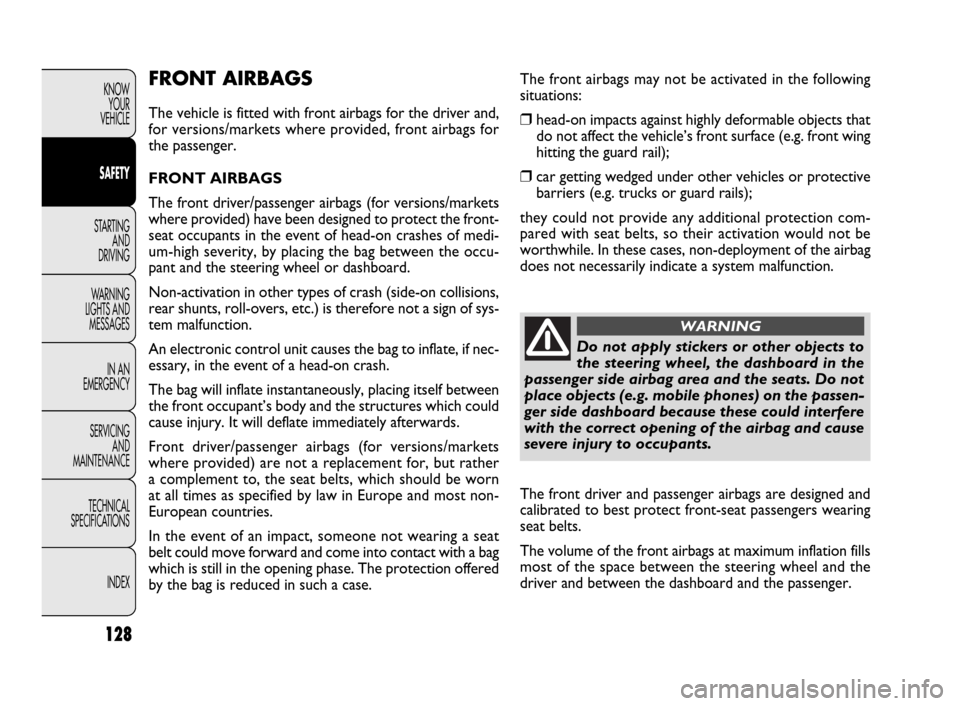
128
KNOW
YOUR
VEHICLE
SAFETY
STARTING
AND
DRIVING
WARNING
LIGHTS AND
MESSAGES
IN AN
EMERGENCY
SERVICING
AND
MAINTENANCE
TECHNICAL
SPECIFICATIONS
INDEXFRONT AIRBAGS
The vehicle is fitted with front airbags for the driver and,
for versions/markets where provided, front airbags for
the passenger.
FRONT AIRBAGS
The front driver/passenger airbags (for versions/markets
where provided) have been designed to protect the front-
seat occupants in the event of head-on crashes of medi-
um-high severity, by placing the bag between the occu-
pant and the steering wheel or dashboard.
Non-activation in other types of crash (side-on collisions,
rear shunts, roll-overs, etc.) is therefore not a sign of sys-
tem malfunction.
An electronic control unit causes the bag to inflate, if nec-
essary, in the event of a head-on crash.
The bag will inflate instantaneously, placing itself between
the front occupant’s body and the structures which could
cause injury. It will deflate immediately afterwards.
Front driver/passenger airbags (for versions/markets
where provided) are not a replacement for, but rather
a complement to, the seat belts, which should be worn
at all times as specified by law in Europe and most non-
European countries.
In the event of an impact, someone not wearing a seat
belt could move forward and come into contact with a bag
which is still in the opening phase. The protection offered
by the bag is reduced in such a case. The front airbags may not be activated in the following
situations:❒head-on impacts against highly deformable objects that
do not affect the vehicle’s front surface (e.g. front wing
hitting the guard rail);
❒car getting wedged under other vehicles or protective
barriers (e.g. trucks or guard rails);
they could not provide any additional protection com-
pared with seat belts, so their activation would not be
worthwhile. In these cases, non-deployment of the airbag
does not necessarily indicate a system malfunction.
Do not apply stickers or other objects to
the steering wheel, the dashboard in the
passenger side airbag area and the seats. Do not
place objects (e.g. mobile phones) on the passen-
ger side dashboard because these could interfere
with the correct opening of the airbag and cause
severe injury to occupants.
WARNING
The front driver and passenger airbags are designed and
calibrated to best protect front-seat passengers wearing
seat belts.
The volume of the front airbags at maximum inflation fills
most of the space between the steering wheel and the
driver and between the dashboard and the passenger.